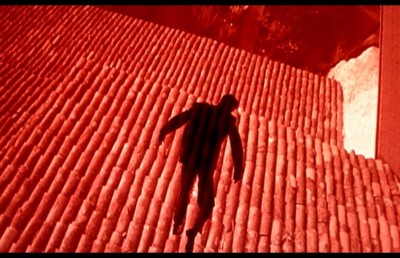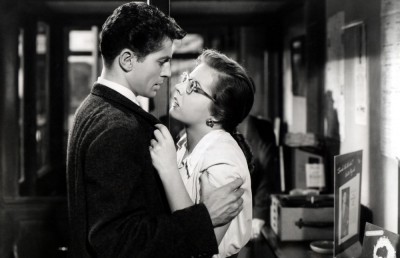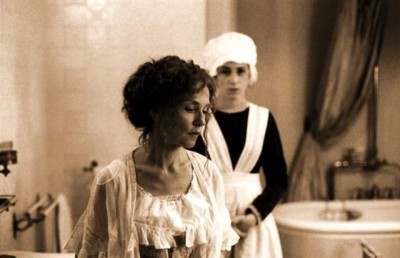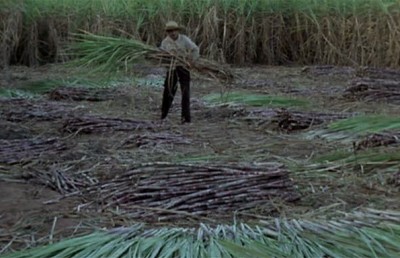Liberations of Mind, Spirit, and Vision: The Fall by Tarsem Singh
Intimacy is possible within grandeur
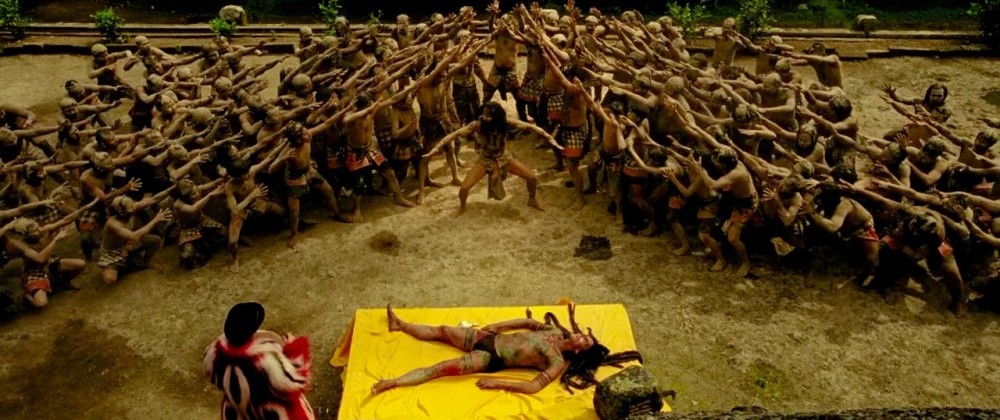
The Fall, directed by Tarsem
Screenplay: Dan Gilroy, Nico Soultanakis, Tarsem Singh
(Based on the film Yo Ho Ho)
Production Designer: Ged Clarke
Art Director: Lisa Hart
Costume Designer: Eiko Ishioka
Cinematographer: Colin Watkinson
Editor: Robert Duffy
Starring: Lee Pace, Catinca Untaru
A Roadside Attractions release
“There’s always three incarnations of a story: the story that is being told, the listener’s interpretation and the version the listener retells in the future.”
—Tarsem, in interview with Benjamin Crossley-Marra of Ioncinema.com
“It is almost impossible to describe.”
—Roger Ebert, on The Fall, in the Chicago Sun-Times
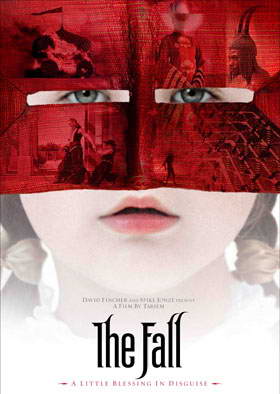
A film that asks us to believe in one scenario is challenge enough; and, a film that asks us to believe in two very different scenarios can overwhelm, especially if one is presented as reality and the other as fantasy, or if one scenario is presented as the past and one as the future, and that difficulty may be the case with films such as Yo Ho Ho and The Fall. Is it possible to hold two very different visions in mind at once? Writing about the 1981 Bulgarian film Yo Ho Ho directed by Zako Heskija, a film about the relationship between two hospital patients, one patient a despairing and storytelling actor with a broken spine and the other a ten-year old boy with a broken arm, the writer Branislav L. Slantchev, who first saw the film when he was in second grade and then again about twenty-five years later, considered his viewing experiences of the film and wrote, “I find myself drawn by the hospital scenes (depicting reality) and find the fantasy somewhat annoying, even as I understand that it is crucial to the story. I do not know whether to deplore that pirates no longer seem that exciting or to welcome the deeper understanding of the themes in the film. It is quite ironic really that by the time one can intellectually grasp the significance of imagination, one is largely deprived of its flights of fancy by the inexorable march of logic” (in a review appearing on the website Gotterdammerung, 2005).
In Yo Ho Ho, the actor tells the boy Leonid a story about pirates involving an international ship’s crew, including an African, an Asian, a native American, and various Europeans; and the actor’s pain, which inspires the seafaring story (he wants to engage the boy so the boy will perform a dangerous favor), also affects the story, in which the actor is inclined to kill off his characters, whom the boy has grown fond of. Despite what he identifies as flaws in cinematography and acting, the writer Branislav Slantchev considers Yo Ho Ho one of the better Bulgarian films of its time. (One wonders what both the boy in the film and Slantchev would make of Johnny Depp’s record-breaking movies about pirates.) Yo Ho Ho, written by Valeri Petrov and starring Kiril Variyski as the actor and the lead pirate and Victor Chuchkov as the boy, is a film seen decades ago by the director Tarsem Singh, who made the beautiful, unique, and controversial film The Cell. (While “The Cell came and went at the box-office, it has since amassed a cult following for its Dali disturbances and hideous theatrics,” wrote Ben Barna of BlackBook magazine, online April 27, 2008). The India-born Tarsem, who might be said to live in airplanes, acquired the rights to make a work based on Yo Ho Ho: a project he kept alive in his mind for more than twenty years, and which took about four years to make: an early edit of The Fall, based on Yo Ho Ho, was completed in 2006 and shown at a film festival, the 2006 Toronto Film Festival, but the final film did not appear in theaters until 2008, presented by the film directors David Fincher and Spike Jonze, who like Tarsem made a name in video production before doing films. The moving picture The Fall, directed by the much-traveled Tarsem, is a beautiful, unique film—and also controversial.
For me, the film is first about the relationship between two people, an American silent film stuntman and a young Romanian girl: in a California hospital, he is depressed by the accident that has paralyzed him and the broken relationship with the woman he loves, and she is recovering from an arm broken while working in orange groves with her family; and, secondly, the film is about storytelling, specifically about a fable the stuntman tells the girl of betrayed love, personal and social violation, and justice that takes place in different parts of the globe, involving mythic characters. The film is a tribute to the silent film age and one of its themes is the costs of storytelling (it has cost the stuntman his body and his lover; and it threatens the well-being of the young girl). The Fall is a tribute to cinema made by a man, Tarsem Singh, who came to America to study film and lost the support of his father for it, leaving Tarsem to work several jobs while going to film school, Pasadena’s Art Center College of Design; luckily, Tarsem received the saving support of his brother, a brother whom Tarsem, after having success in the commercial art world with the videos for REM’s “Losing My Religion” and Deep Forest’s “Sweet Lullaby” and other advertising, then sent to law school. The filmmaker Tarsem says that he is now his brother’s only client.
Film is seductive; and, like other forms of seduction, it is not pure. Our seducers come to us with all kinds of motives and methods; and we can be moved beyond our intelligence with beauty, logic, or truth, or we can be moved by emotion, lies, and violence. Sometimes we are moved by beautiful lies, sometimes by emotional logic, sometimes by violent truths. Tarsem has spoken of the lies that go into getting films made: “When you pitch a story to a Hollywood studio, you’re never telling the story you want to tell them; you’re telling them the story you think they want to hear,” he was quoted as saying by Beth Accomando in the online KPBS log Cinema Junkie, May 30, 2008. Tarsem, insistent on making the film he wanted to make, put his own money, much of it made from doing product commercials, into The Fall, which contains some of the most amazing sights (and sites) ever seen on film, as many different locations are used for the film’s settings, including, reportedly, Argentina, Brazil, Chile, China, the Czech Republic, Egypt, England, Fiji, France, India, Indonesia, Italy, Namibia, Romania, Spain, South Africa, Turkey, and the United Arab Emirates. (Reports of the number of countries have varied, from eighteen to about thirty-four. Tarsem preferred geography to computer-generated imagery, CGI.) Tarsem told BlackBook magazine’s Ben Barna, “The Cell was all CGI and theater, on a stage, whereas The Fall was all landscapes” (April 27, 2008). The Fall, for which scenes in the reality portion were filmed first, followed by scenes in the fantasy portion, is a seductive movie about seduction.
It is impossible not to have a sense of anxious anticipation as The Fall begins, in black-and-white, with a view of a railroad tracks over a bridge and people gathered, working over the water. (It is “the most pristine black-and-white footage since the Polish Brothers’ Northfork,” wrote the _Independent Weekly_’s mostly damning film reviewer Neil Morris, May 28, 2008, referring to the work of Mark and Michael Polish). When a horse is dredged up, it is a surprise (one is tempted to write “a mystery”), but the horse was part of a film production accident that has occurred—the other part involved a young man, a stuntman, Roy. He is taken to a hospital, and it is the same one that little Alexandria is in; and they meet when she writes a note for someone else, tosses it, and it enters his, Roy’s, room through a window. They begin to talk, and slowly things are revealed (we know he is paralyzed after she touches one of his toes and he tries to guess which one); and then there is Roy’s fantastical storytelling. Roy begins by connecting Alexandria’s name to Alexander the Great—and we see Alexander and his thirsty men, in a desert, brought a helmet of water, which Alexander spills, as it is not enough for all. Roy says it was wise for Alexander to do so, but Alexandria thinks everyone could have gotten a little water.
“Terribly cerebral, meticulously staged and extravagantly costumed, the film pays homage to the foundational principles of moviemaking, from Alexandria’s shadow play on a hospital wall to an accidental camera obscura created by sunlight through a keyhole,” wrote Ann Hornaday in the Washington Post (May 30, 2008). Whereas Christopher Nolan’s Batman film The Dark Knight was released in more than four-thousand theaters, Tarsem’s The Fall was released in a little more than one-hundred theaters, where it attracted a small but consistent audience; and it has received both critical appreciation and dismissal. The _Chicago Tribune_’s review by Michael Phillips declared, “It has a rich premise and no lack of amazements. What it lacks is any sort of dramatic shape” (May 30, 2008).
It is peculiar to read or hear anyone say that the film lacks drama or dramatic shape, when it seems so much about relationship, and contains stories within stories. Relationships have a natural drama and this one, between the two hospital patients, the young man and the little girl, Roy and Alexandria, is quite believable and affecting. The actor who plays Roy, Lee Pace, is known to others, apparently, through his work in the 2003 television film “Soldier’s Girl” and the recent (2007-2008) television series “Pushing Daisies,” and the theatrical films The Good Shepherd (2006) and Miss Pettigrew Lives for a Day (2008), but he is a new discovery for me. Lee Pace has a warm presence—intelligent, sensitive, sensuous, but not emphatic, not pushy; rather, Pace seems natural—and it is a presence that welcomes and fills without overwhelming the screen. Lee Pace plays his bedridden stuntman Roy’s charm and calculation, his despair and anger, beautifully. Early on, when Alexandria shares a communion wafer with Roy, and he asks her if she is trying to save his soul, she does not understand the question, he repeats it—and, later, the question does reverberate. (His repetition of the question adds verisimilitude to their conversation.) Roy’s relationship with the girl slowly develops, as she visits him over a period of days. Watching her, Catinca Untaru as Alexandria, I found her both strange and familiar—I thought she was very, very appealing, distinct, and yet she reminded me of children I knew and, also, I could hear an echo of impressive—beautiful, vivacious—young actresses of the past. It was a startling effect. That the relationship of Roy and Alexandria develops surrounded by other relationships, including the stuntman’s colleagues who visit (an actor who lost a leg talks about getting more work after the loss), and the doctors and nurses and other patients in the hospital, adds texture. How Alexandria’s responses—her curiosity, her affection, her sadness—affect the fable Roy tells is also fascinating; and even there, we see stories and more stories.
We can go to stories for their beauty, order, and truth. Roy’s fantasy contains many of the things we go to stories to find—adventure, emotion, romance, and spectacle; and we can go to stories sent by various causes: boredom, curiosity, despair, ignorance, illness, pain, poverty—feelings or states we think the stories can distract us from or transform, just as Roy’s stories give Alexandria’s hospital life new purpose and delight. Her pleasure alone is not his concern—he asks her for a favor in exchange for the fantasy. One of the stories Roy tells is about an Indian man whose fiancée is abducted. One of the stories that Roy tells Alexandria is about an enslaved African whose brother is killed, and in his grieving rage the African frees himself and the other slaves. There are five stories, five heroes, who work together to bring justice to an odious governor who has wronged each of them. Alexandria gives the fantasy characters the faces of the people she sees around her. It is amusing to see people in the hospital, such as an orderly or ice deliveryman, transformed in the stuntman’s story and Alexandria’s imagining (into a monkey-carrying Charles Darwin, into an African warrior). The stuntman-patient Roy says that one of the characters is an Indian, meaning native American, but the girl thinks and sees an east Indian. In similar ways, in our own lives, we transform the people we know into actors in our own life stories (or, transform people into actors in our personal fantasies or social lies); and we interpret—and misinterpret—the things that other people tell us. The actors in the fantasy sometimes act “naturally” and sometimes act with the style of silent film actors. Alexandria’s own mood is transformative—her needing to go to the bathroom to relieve herself translates into a fantasy character’s perceptible physical discomfort. Alexandria’s fear of a hospital technician’s protective garb transforms that into the ominous uniforms of soldiers in her imagination of Roy’s tale.
The importance of the right child is obvious, and even shockingly confirmed, when Tarsem admits, as Tarsem did in interview for The Onion_’s A.V. Club, which covers the audio-visual realm—principally film and music, that Tarsem allowed the child to dictate much of the film (an interview with Tasha Robinson, May 20, 2008). Tarsem spent about six years looking for the right child, knowing he wanted a genuine kind of response, knowing he would allow improvisation. (Tarsem mentions his admiration for the film Ponette, and also the work of film director Yasujiro Ozu for the intimacy of his scenes.) When Tarsem found the Romanian girl Catinca Untaru, she was six years old and did not speak English, though she quickly learned (first imitating Tarsem’s English, including his Indian accent: then Tarsem got Romanians to communicate with her for him). Film critic Roger Ebert wrote, “One of the treasures of the film is the sound of the dialog by Catinca Untaru. We understand every word, but she sounds as if she’s inventing them as utters them” (_Chicago Sun-Times, June 3, 2008). One can see the girl’s increasing intimacy with the bed-bound Roy (and with actor Lee Pace) and with the English language. Catinca Untaru’s early conversations contain charm and hesitation but her later conversations contain conviction and judgment; and her decisive judgment—which is part of an actress’s craft—seems to come out of Alexandria’s affection for Roy. Young Alexandria’s explaining to an adult nurse Roy’s need of sleep, of rest, is etched in my mind. (Tarsem allowed Catinca Untaru and others on the film set to think Lee Pace was incapable of walking, which gave the set a serious or somber quality—and even made Pace depressed with time.) In Roy’s fantasy story, the elegant bandit’s lady is captured by another man, something that happened to Roy in his “real” life, when his girlfriend became involved with a male star; and it happens to one of the bandit’s associates—the bandit’s other associates have had various problems with the cruel, rapacious governor they seek to find. When Alexandria guesses that the woman in Roy’s fantasy story and Roy’s actual girlfriend shared conflicted feelings and infidelity, one both relishes the little girl’s intelligence and honesty and senses Roy’s heartbreak anew. These are moments of perception that artists work to inspire.
“There’s a playfulness in the storytelling as Roy’s tale involves people around the hospital—a nurse at the hospital (Justine Waddell), a one-legged actor (Robin Smith), the ice deliveryman (Marcus Wesley), and a local orange picker (Jeetu Verma)—and as the disjointed tale is embellished by Alexandria’s overactive imagination. The film serves up an odd contrast—Singh’s grandiose, heavily designed images, and the simple playfulness of a child,” wrote Beth Accomando in Cinema Junkie (May 30, 2008); and the writer found the child’s presence refreshing, the saving factor in the film (she also called the film “gourmet eye candy for the art house crowd”). However, it is important to note that there is almost always a difference between what children imagine and what adults know. For that reason, the fantasy sequences—as outlandish as they are—can be seen as embodiments of perverse adult knowledge. The fantasy sequences in Yo Ho Ho and The Fall are both focused on the desire for justice against a corrupt governor: that governor might be the symbol of an actual leader or he might stand in for life itself, brutal, careless, unfair, and wanton. The most fearful thing in the fantasy for Alexandria is the prospect of death for the characters, but what is more inevitable, more real, than death?
There is a scene near the end of The Fall when both Roy and Alexandria are moved to tears—and it seems to go on too long, it seems to be happening in real time rather than film time (one realizes that films are more glimpses and suggestions than documentations or explorations), and at first I found the scene a bit too much, and then I liked it. The scene is a culmination of their different perspectives—her hope, his despair—and their concerns for each other, for story, and for truth. Yet, it seems acceptable to believe that Roy’s storytelling and Alexandria’s imaginings are both windows that allow us to see Tarsem’s vision: that there are things he wants to say to us and show to us that he can do through them. That is not unlike certain old-fashion stories and even films which take as their starting point a particular character’s view before expanding into a more general and much larger view. The film is full of connections—aesthetic, emotional, narrative. We are able to see something of how stories are put together, how acts, feelings, and ideas, are seen and transformed, made motivational, made symbolic. I find that acceptable, I find it rich, but it seems to be what has repelled some people—who seem to resent the beauty, the largeness of vision, the jewel-like small island, the swimming elephant, the mountain of orange sand, the tree spirit, the tribal ritual, the dizzying labyrinth, the blue city, the exquisite costuming, the whirling dervishes, the birds that fly out of one man’s mouth, etc. Tarsem’s vision is too specific and too sophisticated for some tastes. It is, also, genuinely strange: when one of the characters in Roy’s fable is shot in the back with many arrows, he falls backward, his body resting on the arrows like a table top on table legs, an image of absurdity, beauty, and pain. How does one respond to that?
When I first saw the man shot then held aloft by arrows, a man who then offers reassuring words, I had reservations about the image and his words, they irritated me, but I now hear his words as attempts to reassure the girl regarding the acceptability of death, rather than the ability to tolerate extreme pain. How do we analyze the characters, their acts, and their words, in The Fall, and the images they form? Alexandria throws an orange at a priest—is that only a childish prank? The round shape of oranges have been said to suggest eternity, unbroken time, immortality, and the Christ child has been painted holding an orange. Is Alexandria meant to be a figure of a holy child, taking the position of the priest, tending to Roy’s soul? Alexandria pleads for Roy to allow his fantasy heroes a more optimistic destiny, pleads for him to have faith in possibility. How far does one go in examining the imagery in the film, knowing that symbolism is only one level of meaning in a film?
In his May 9, 2008 Los Angeles Times review of The Fall, a review I find disagreeable, Marc Olsen wrote, “Tarsem underlines the film with truly obnoxious levels of pretentiousness that insist on the pretty pictures as having capital-M meaning, which only brings into sharp relief what a hollow exercise it all really is. Like De Chirico does MTV in the ’80s, his ideas of what constitutes ‘artful’—mostly consisting of slo-mo, tableau framing, strange costumes and a romanticized exoticism—seem at best encased in amber and at worst completely regressive. For a film that wants to present itself as extravagantly dazzling, there is something thuddingly familiar and bland in its vision.”
Watching the film, I felt as if I had been given something special—a wonderful way to feel. The film held my attention, and gratified it. It was sad to contemplate the real reason for Roy’s storytelling, and disturbing to follow his manipulation of Alexandria, his asking her to find and secretly take from the pharmacy medicine he said he needed to sleep (really, asking her to steal—morphine). There was ugliness beneath the beauty that Roy created for Alexandria. Roy built Alexandria’s trust only to betray it, something that—if his suicidal plan worked—she would find out but too late. Yet, it was thrilling to see the far-off wondrous places that actually do exist, places that Tarsem managed to bring together—in one fantasy, in one film. Is there anything simple about any of that? Tarsem balanced intimacy with grandeur.
As Ann Hornaday wrote in the Washington Post (May 30, 2008), Tarsem “shows deep affection for a medium of virtually unbounded imaginative expression.” The Fall is, certainly, one of the most memorable films I have seen. It is worth seeing for beauty alone—but it offers more to think about. In an age when literature and philosophy are not given the pride of place they once were, the things that are—such as television and film, music and sports, science and technology—must be more richly imagined and more rigorously considered. Tarsem has said, “I wouldn’t say I’m original, but the sources that inspire me are alien to everyone else, so I seem original” (BlackBook, April 27, 2008). Tarsem’s loves are diverse—among them, the writers Borges and Gabriel Garcia Marquez, Polish cinema, Coppola’s Dracula, Tarkovsky, painter Caravaggio, photographer Joseph Koudelka, and erotic imagery as well as the imagery of different religious traditions; and viewers have seen in his work reference to Derek Jarman, David Lynch, Alejandro Jodorowsky, visual artist Damien Hirst, The Wizard of Oz, and the stories of Grimm and Arabian Nights.
When noticed, some of Tarsem’s influences have been regarded with an odd derision, including in commentary by writers for The New York Times and IndieWire. (Is it so that when you outrage the establishment and the fringe, the left and the right, the top and the bottom, of a society, you must be doing something right—or something terrible?) The _New York Press_’s Armond White wrote, “Presented by both David Fincher and Spike Jonze, The Fall angles to be a major event. It represents that artsy realm of music video by the generation of classy imitators who owe an unmistakable debt to visionaries Tarkovsky, Fellini, Ken Russell, Derek Jarman, Paradjanov. It’s meant to crown what should rightly be called the post–music video era (vets like Jonze, Marcos Siega, Michel Gondry having gone on to make some of the most distinctive movies of the past decade). But given his catalog of styles, Tarsem works like a surrealist without political bona fides” (May 6, 2008; Volume 21, Issue 19). One might imagine, contrarily, that men of different cultures working together to defeat a corrupt power, as in The Fall, suggest a political vision, especially if one of those men was a self-freed slave. One might imagine that an artist knowing art history is good thing. Tarsem himself has said that if he had cultivated the film festival audience, the reception for his work might have been different (one guesses there would be fewer cynical references to his commercial work). Yet, the associations of Tarsem’s visual imagery is not to anything ordinary but to some of the most complex, provocative, and respected work by artists of canvas and film. Shouldn’t the history of art—whether paintings or cinema—have an influence on subsequent ways of perceiving, and on image-making? Shouldn’t new art, such as twentieth century art, if it is good, if it is serious, find its way into newer works, such as twenty-first century films, in a perceptible way? Isn’t that precisely what Tarsem is doing, bringing that heritage to our eyes, to our minds? Isn’t his arrangement of those influences—using them for his own work, in his own way—what is expected of a serious artist? Isn’t that what artists provide, and what culture is—an influence on sensibility?
As noted, The Fall was presented by Spike Jonze and David Fincher, two friends of Tarsem. (Spike Jonze directed videos for the Beastie Boys, REM, and Bjork, and made the films Being John Malkovich, in 1999, and Adaptation, 2002; and David Fincher directed videos for Madonna and Aerosmith, and made the films Alien3, 1992, The Game, 1997, Panic Room, 2002, and Zodiac, 2007.) Tarsem, comparing himself to Spike Jonze and David Fincher, in BlackBook magazine, said, “My work doesn’t look anything like theirs, but I kind of find I’m in between the two. For Spike, it’s all about character. He doesn’t give a shit about what the image looks like. And for Fincher, if someone’s head isn’t cropped right, no matter how good the performance is, he’ll toss it” (BlackBook, April 27, 2008). Does Tarsem’s work look, really, like that of any other film director; and what if it does?
I think there are particular concepts, particular ideals, that make appreciating Tarsem’s work difficult for some people—and those are authenticity, simplicity, and originality. Authenticity and simplicity are taken to refer to what is ordinary, to what is expected in average lives, including the lives of most film critics and reviewers: displays of beauty, eccentricity, erudition, wealth, and power, especially in great amounts, go against what it is to be found in many lives. Great resources intimidate—and Tarsem’s work suggests great resources. Tarsem’s films display the rare, the unusual. His films subvert the corroborating instinct—how can anyone confirm what is authentic in Tarsem’s stories if he (or she) has not seen anything like them in his (or her) own daily life? The most obvious reference for understanding Tarsem becomes not life but art—other art; and there is a love/hate relation to art, even among some thinkers and writers, from Plato’s time until ours. Art can be created for love or money, out of ego or truth, or any combination of elements. Although art is very often created out of the most loving craft, out of thoughtful practice, out of effort and passion, by too many people art is seen as false (think of the related words: artifice, artificial, arty, words with negative connotations). In evoking the specter of art, Tarsem inspires a challenge to his own authenticity, simplicity, and originality. (Our highest compliment often is, That is like life: but, frequently, that compliment refers to things being in correspondence with our conceptions of life rather than with amoral, brief, chaotic life itself.)
I am reminded that art may not be complete until it has an audience—a listener, a reader, a viewer; and that some works overwhelm an audience. The Fall requires a significant amount and quality of attention. It may be telling, very telling, that several of the publications that have published the most questionable, or the nastiest, film review comments have included errors regarding film content and description as part of their reviews: The May 28, 2008 Independent Weekly review that called the movie a “phantasmagoria of pretentiousness” also wrote that Alexandria “is recovering from a broken collarbone,” though she walks through most of the film with a bandaged arm. The IndieWire (May 6, 2008) report, which asserts that Tarsem is “a classic case of a natural-born cinematographer playing at being a filmmaker,” claims that the nurse (Evelyn, played by Justine Waddell) was Roy’s girlfriend, which is not true. (Alexandria’s nurse appears in the fantasy as the lead bandit’s desired object; but, the crying woman who is suggested as Roy’s faithless lover is actually played by Camilla Waldman.) As well, two descriptions of Alexandria might inspire wonder as to whether the writers are being matter-of-fact or issuing an odd rejection: the May 6, 2008 New York Press review says she is a “fat-cheeked urchin” and her talk is “mumbly baby babble”; and the sarcastic May 9, 2008 New York Times comment, which derides the film as “a threadbare patchwork of postcard exoticism, turgid characterizations, stilted duels and lackluster spectacle,” remarks that Alexandria is “pudgy.” Whose body image standard is the child expected to meet and why? Is it wise to trust the critical interpretations of the inattentive or the cynical? Perhaps one antidote to the poison is Roger Ebert, who has written about the film several times, calling it in one article one of the best films he has seen all year, and in another a “free-fall from reality into uncharted realms,” before declaring, “Either you are drawn into the world of this movie or you are not. It is preposterous, of course, but I vote with Werner Herzog, who says if we do not find new images, we will perish” (Chicago Sun-Times, May 29, 2008).
The Fall is a difficult film to describe—instead, it must be experienced. In the film Alexandria and Roy, two people of different ages, cultures, genders, and temperaments meet and become friends; and one moves from innocence to experience and the other moves from doubt to hope, or at least to a more positive acceptance, and together they go from isolation to community, sharing the pleasures of film culture when there is a screening in the hospital in which they are recuperating. In the fantasy of five heroes Alexandria and Roy share, the heroes travel and reach the province of the troublesome governor they sought, the end of their journey. However, The Fall is a film in which the journey itself is as important as the journey’s end. The Fall cannot be reduced satisfactorily to a single idea or a single image. I think that its director Tarsem is brave: in a time when complex culture is receiving repudiations in the very institutions that might have been expected to maintain it, Tarsem is claiming that culture; and I think culture must claim him—and claim him for his courage and creativity and the refreshment his work gives.
It must be said that there are times when we do not need authenticity, simplicity, or even originality—certainly not as commonly understood: as expressions of the crudest impulses, the most primitive knowledge, and a lack of connection to a tradition of human excellence. There are times when we require other things—beauty, eccentricity, erudition, wealth, power. There are times when we require individuality. There are times when we require fantasy. There are times when we require a liberation of mind and spirit that can come only from a rejection of the clichéd but cheerily championed connotations of authenticity, simplicity, and originality. Sometimes the exercise of will demands the rejection of reality as received. Sometimes art and artifice correspond more closely to spirit than anything in ordinary life: and speak more to our imaginations, our spiritual needs, our desires. Of course, too, what is fantasy today might be reality tomorrow.


